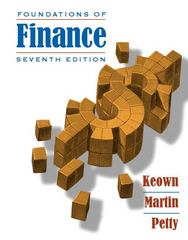Question
You have just turned 22, and you intend to start saving for your retirement. You plan to retire in 41 years when you turn 63.
You have just turned 22, and you intend to start saving for your retirement. You plan to retire in 41 years when you turn 63. During your retirement you would like to have an annual income of $165,000 per year for the next 28 years (until age 91).
- Calculate how much has to be in your account before the first withdrawal at age 64. (2 points)
- Calculate how much would have to save annually between now and age 63 in order to finance your retirement income and to fill that account. (2 points) Make the following assumptions:
- Assume that the relevant compounded interest rate is 9 percent for all 69 years.
- You make the first payment today and the last payment on the day you turn 63.
- You make the first withdrawal when you turn 64 and the last withdrawal when you turn 91. PROBLEM # 2: You just took a $125,000, seven-year loan. Payments at the end of each month are flat (equal in every month) at an annual interest rate of 4.75 percent. Calculate the monthly payment. (2 points) Provide the appropriate loan table, showing the breakdown in each month between principal repayment and interest. (2 points)
PROBLEM # 3:
You are offered an asset that costs $14,000 and has cash flows as follows below at the end of each quarter for the next 8 years. Then it will be sold for $2,500. Your cost of capital is 6.5 percent. An alternative (mutually exclusive) project is available which offers an accounting rate of return of 8%, a classical payback period of 5 years and a discounted payback period of 5 years.
Year 1: $800 each quarter Year 2: $850 each quarter Year 3: $850 each quarter Year 4: $950 each quarter Year 5: $800 each quarter Year 6: $600 each quarter Year 7: $500 each quarter Year 8: $400 each quarter
- a) What is the IRR of the asset? (2 points)
- b) What is the NPV of the asset? (1 point)
- c) WhatarethePIandNPIoftheasset?(1point)
- d) What are the classical and discounted payback periods? (1 point)
- e) What are the four accounting rate of returns (utilizing cash flows)? (1 point)
- f) Should you purchase it? Base your answer on your solutions of a) to e) (2 points) (A simple yes or no is not enough.)
(Use your calculator to make sure that the answers are correct. Read chapter 19 before you start doing the problem.)
Step by Step Solution
There are 3 Steps involved in it
Step: 1

Get Instant Access to Expert-Tailored Solutions
See step-by-step solutions with expert insights and AI powered tools for academic success
Step: 2

Step: 3

Ace Your Homework with AI
Get the answers you need in no time with our AI-driven, step-by-step assistance
Get Started


